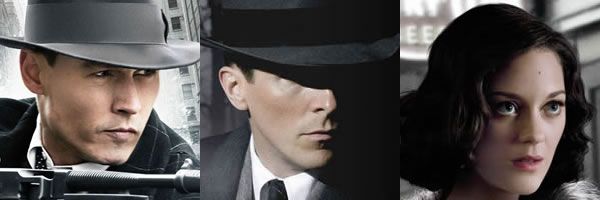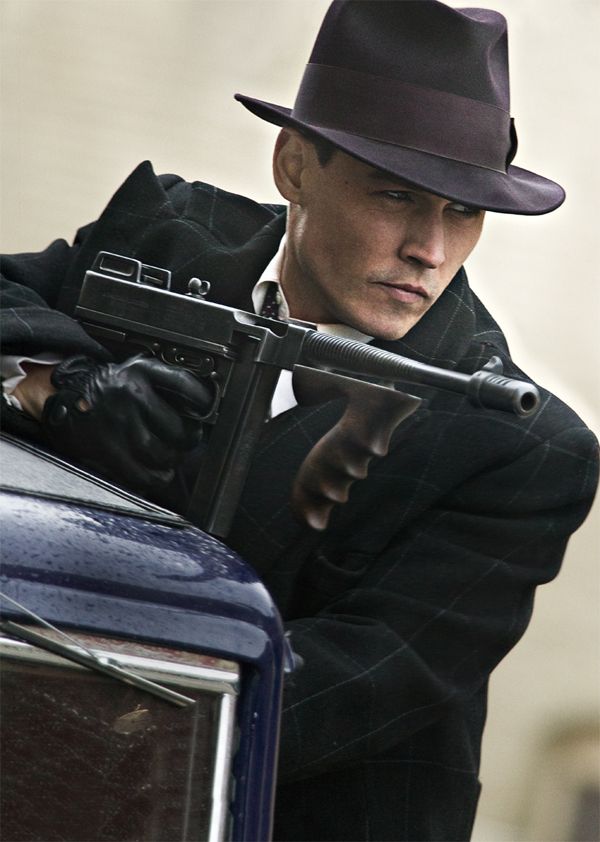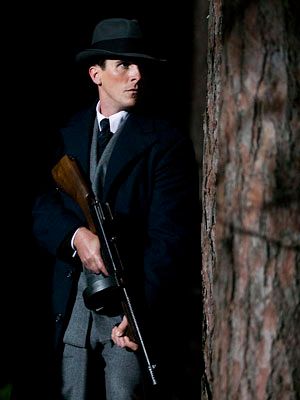I root for Michael Mann even when he missteps, because he is one of America's premier filmmakers, and one of the great visionaries of cinema. And, really, he's only been building up steam. TV seemed to occupy him in the 80's (even with three efforts, the best being Manhunter), but it wasn't until 1995 that he really struck gold with Heat, and followed that up with The Insider. Both of which qualify as two of the best films of the 90's. Since then it's been a film every two or three years, and though none have been as great as those two, they run from the interesting to awesome. Public Enemies falls more into the interesting than awesome camp, but it is definitely solid, albeit familiar ground. My review after the jump.
Johnny Depp stars as John Dillinger, the bank-robbing, folk-hero of his era. A little bit Robin Hood-ish, the film beings with him breaking some friends out of jail, and then moving on to a robbery. Afterwards he meets Billie Frechette (Marion Coutard), the woman he falls in love with, and takes to Florida. Melvin Purvis (Christian Bale) makes his reputation by hunting down Pretty Boy Floyd, which puts him in good with J. Edgar Hoover (Billy Crudup). Hoover wants him to run down Dillinger, who's made Public Enemy #1. Dillinger is eventually caught, and then escapes, only to find himself working with people he doesn't like, such as Baby Face Nelson (Stephan Graham), while the mob is beginning to do away with bank heists because it interferes with their bookmaking, which is infinitely more profitable. Purvis at first finds himself surrounded by men who are bookish, and convinces Hoover to send him Texas Rangers to make sure that the bad people get shot by men know how to do it. Eventually, Purvis and company close in.
There is so much going on in Public Enemies that it's a shame some of the ideas didn't come into greater focus. Instead it feels like a collage of what Michael Mann is obsessed with without ever achieving the heft of his best work. The opening scene for Purvis has him using a bolt-action rifle to take down Floyd, which suggests that perhaps the public enemies are a dying breed being hunted down (though they have Tommy Guns, so there's that), but this idea never takes off thematically more than in that scene and in the scene where the mob explains why they want nothing to do with Dillinger. Mike D'Angelo talked about the scene where Dillinger walks through the police station where he sees the photographs of his entire life and career, and the idea that this scene represents how the disconnect of that era as being observed, photographed, etc. was not so much a part of that culture, and that the film begins the era of surveillance. This is complimented by the scene in the theater, where no one notices the criminal. I like the scene in the police station, because I see it as Dillinger, already in some ways dead, getting the last look at what has led him to this place.
You also have Purvis doing the classic "torturing the suspect" scene, where he takes things too far because of the man he's become because of the job he's been given. You also have some immaculately staged heists, and a stunning nighttime shoot out. But perhaps Mann and company got too invested in some of the facts to bring the pieces together. The film instead serves as a collection of moments, all of interest, but compared to Heat, it suffers. Partly because the Purvis side of the story is of less interest, and Depp's Dillinger takes over the movie. The title of the film may be a clue in that this is Mann's take on the classic gangster fable, which invokes a raise and a fall, but here there's not so much a rise as a steady decline. I wonder what is meant in the title, as it alludes to - quite specifically - the Cagney take on gangsters. You could argue this is the film meant to right some of that, but again, it seems a notion, not the thesis. I like that about the film, and I've now watched the film twice at home, but it's definitely more Casino than Goodfellas.
At home the film plays a bit better, because theatrically - if you weren't watching the film digitally projected - the camerawork made you aware of its digital origins. Some of the shots (particularly those lit by flare) showcase what digital cinema can do at its best, but where Miami Vice and Collateral either benefited, or weren't hurt by the digital photography, Mann's work here with cinematographer Dante Spinotti does not seem interested in hiding the fact that it is video. For some this made it feel like a school production of period (which is interesting in and of itself), but when the film was shown projected, the digital artifacts were more pronounced. At home in 1080, it breathes as the digital to digital transfer is a better presentation that most people got in the theaters. I'm of the opinion that the texture of video is such that I can't disassociate it from its homemade roots, so I like it when it doesn't look too digital or the filmmakers embrace the look as part of a documentary feel (as they did with District 9). On Blu-ray, the film feels like this was the way it was meant to be seen.
Universal's Blu-ray edition also comes with a digital copy. The film is presented widescreen (2.35:1) and in 5.1 DTS-HD. Extras include a commentary by Michael Mann, and two U-control streams, one a PIP with behind the scenes interviews and footage, and the second a historical interactive timeline, which focuses on the real events oin the film and is highlighted by interviews and behind the scenes footage. This is all complimented by the five featurettes on the making of the film. "Larger than Life: Adversaries" (10 min.) talks to the relationship between the two main characters, and how the actors played them, while "Michael Mann: Making Public Enemies" (21 min.) lets the director have his say, "Last of the Legendary Outlaws" (9 min.) talks to the training that went into doing the heists, and "On Dillinger's Trail: The Real Locations" (10 min.) suggests they went to the exact spots these characters were at in crucial scenes of the movie. There's also "Criminal Technology" (10 min.) which talks of the antiquated techniques used to track Dillinger. The set wraps up with a trivia game "The Gangster Movie Challenge," which asks you trivia questions about this film, and other Universal gangster pictures (Scarface, American Gangster, Carlito's Way).





.jpg)